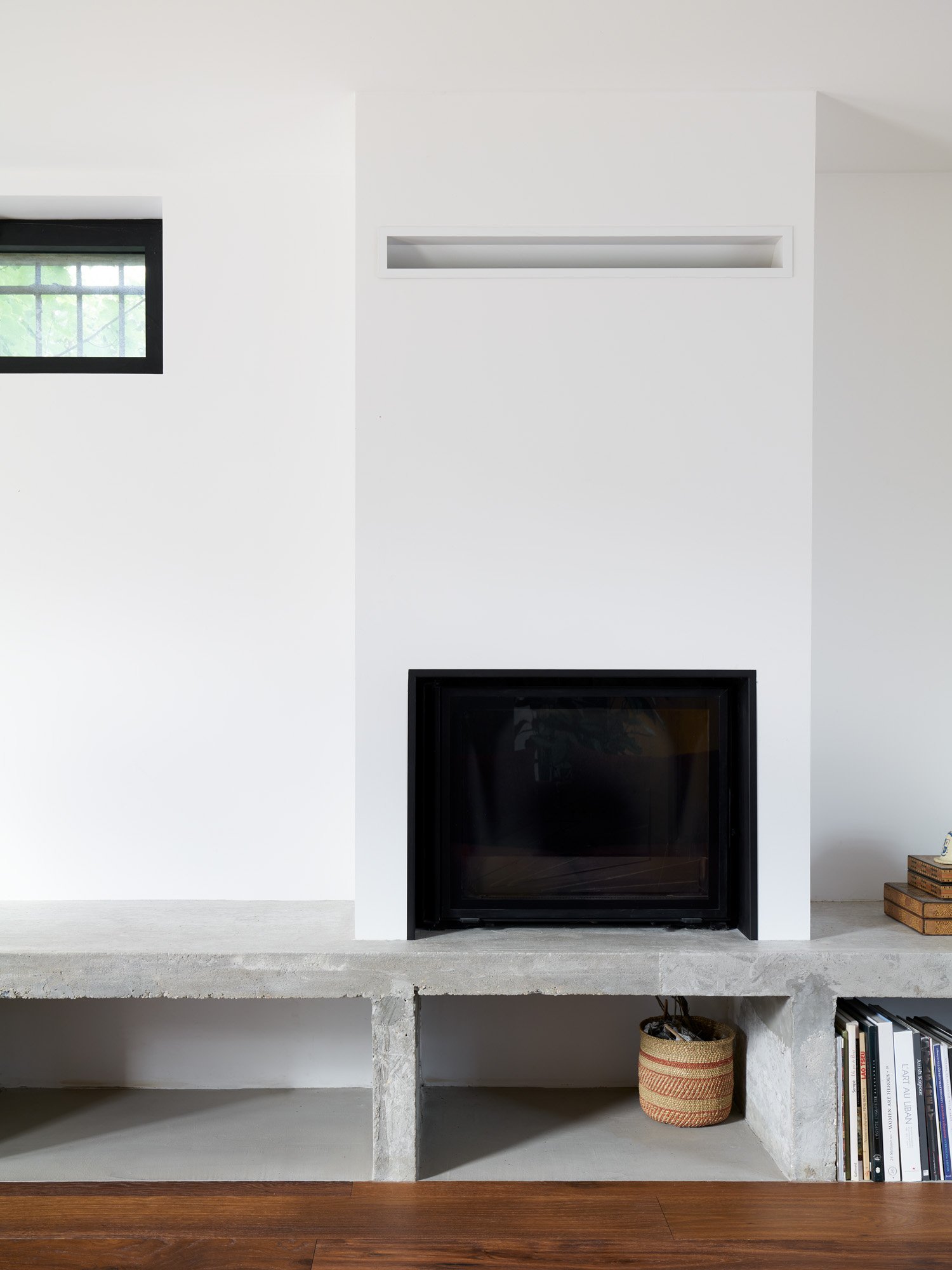romainville
Location : Romainville (93), France
Date : 2023
Area / Surface : 250 m²
Budget : N/A
Pictures © David Foessel
Collaborators : Rémy Feret, Jeremy Moreuil, Robin Thomas
Romainville
In the center of Romainville, just a few streets away from the main housing estates, a long plot of land occupied by a collection of chaotic buildings, partly intended for an initially agricultural activity, with its back to the garden and a patio, has been transformed and extended to create a house that is reconnected to its context, facing outwards and ensuring the articulation of spaces and eclectic architectures to house a family.
Recomposing fragmentation
The context: a long parcel of land, the result of the re-cutting of a large plot, or the countryside in the city. A building on the street, with a depth of 70m, and a succession of 3 buildings: a green steel veranda, probably added in the 1980s, and two older constructions: the first leaning against the veranda (ground floor + attic), the second across the plot (a technical ground floor; a dirt garage, r+1 and attic). Between these two buildings, a henhouse, a paved courtyard and a cherry tree. At the far end of the plot, a wild garden whose boundaries with neighbouring gardens remain blurred.
The contextual response: two extensions, one of which overlooks the courtyard, providing a watertight, airtight connection between the 2 existing buildings, some 15 m2 of floor space, including an entrance hall, ground-floor sanitary facilities, a staircase leading to the first floor and a bathroom for the children. The glazed volumetry opens onto the courtyard, with dividing spaces benefiting from views and light, while the volumetry of the R+1 creates a cantilever, with an old upstairs window transformed into a door. The rendered masonry and framing around the bays are inspired by existing buildings, creating a homogeneous whole.
Interior - exterior
While the existing buildings turned their backs on the garden and opened up to the south-facing courtyard, the new building was designed with the garden in mind. The entire first floor of the two existing houses and the two extensions is dedicated to the house's communal spaces. The office, children's playroom and entrance face the courtyard. The living room and kitchen open onto the courtyard and garden. The dining room is housed in a glazed extension on the garden side, overlooking the landscape. The facade of the courtyard extension is entirely glazed, making the cherry tree a permanent landscape landmark.
Structure - reuse
To ensure that the project blends seamlessly into the site, care was also taken to design a virtuous project. The heavy structural work generated a substantial quantity of rubble, which was crushed for reuse as fill, and crushed to pour part of the large quantity of concrete required for the structural work. This work was highlighted by leaving the rough concrete structures visible. OSB panels were used to give texture to the concrete, in slabs and vertical walls. In order to respect the existing elements, the parquet floors were preserved and renovated, and the foundations of the garden extension were modified on site to bypass the roots of the preserved cherry tree as far as possible.
Romainville
Dans le centre de Romainville, à quelques ruelles de grands ensembles, un terrain en longueur occupé par une collection de de constructions chaotiques en partie destinées à une activité initialement agricole tournant le dos à jardin et un patio ont fait l’objet de transformations et d’extensions destinées à offrir une maison reconnectée à son contexte, tournée vers l’extérieur et assurant une artciulation des espaces et des architectures éclectiques pour loger une famille.
Morcelage à recomposer
Le contexte: une parcelle en longueur, issue du redécoupage d’un grand terrain ou la campagne en ville. Une construction sur rue dont rien ne laisse supposer 70m de profondeur de terrain, et la succession de 3 corps de bâtiments: d’une part une véranda en acier vert vraisemblablement ajoutée dans les années 80 et d’autre part deux constructions plus anciennes: une première adossée à la véranda (rdc + combles), une seconde en travers du terrain (un rdc technique; un garage en terre battue, r+1 et combles). Entre ces deux corps de bâtiments, un poulailler, une cour pavée et son cerisier. En fond de parcelle, un jardin sauvage dont les limites avec les jardins voisins demeurent floues.
La réponse contextuelle : deux extensions dont l’une sur cour assurant la connexion hors d’eau, hors d’air entre les 2 constructions existantes, une quinzaine de m d’emprise au sol: intérgrant une entrée, un sanitaire à rdc, un escalier menant à l’étage et une salle de bain dédiée aux enfants. La volumétrie vitrée s’ouvrer vers la cour, les espaces disctributifs profitent de la vue et de la lumière, la volumétrie du R+1 génère un porte à faux, une acienne fenêtre de l’étage étant transformée en porte. La maçonnerie enduite et le cadres autour des baies s’inspirent des constructions existantes pour offrir un ensemble homogène.
Interieur - exterieur
Alors que les constructions existantes, tournaient le dos au jardin et s’ouvraient maigrement vers une cour pourtant orientée sud. La totalité du rez-de-chaussée des deux maisons existantes et des deux extensions est dédié aux espaces communs de la maison. Le bureau, la salle de jeux des enfants et l’entrée sont tournés sur la cour. Le séjour et la cuisine sont traversants et s’ouvrent sur la cour et le jardin. La salle à manger est quant à elle disposée dans l’extension vitrée côté jardin, en promontoir cette extension surpombe le paysage. La façade de l’extension sur cour est entièrement vitrée, le cerisier devient un repère paysager permanent.
Structure - réemploi
Soucieux d’insérer le projet au mieux dans le site, une vigilance a été également apportée pour concevoir un projet vertueux. Les travaux de gros oeuvre lourds et structurants ont généré une conséquente quantité de gravats qui a été broyée afin d’être réutilisée en remblais, broyé pour couler une partie de l’importante quantité de béton nécessaire aux travaux structurels. Ce travail a été mis en valeur en laissant les structure béton brutes visibles. Des banches en OSB ont été utilisées pour donner une texture au béton, en dalles et parois verticales. Dans un souci de respect des éléments en place, les parquets ont été conservés et rénovés et les fondations de l’extension côté jardin ont été modifiée en chantier pour contourner autant que possibles les racines du cerisier conservé.






















